With food prices rising at an alarming rate (19% at its highest this year) and utility bills skyrocketing, it seemed like a good time to look at some ways of combatting the increasing cost of living without compromising on life-style. As anyone who follows this blog knows, I am a total foodie. Whenever possible, I buy organic and the best quality that I can, but I do believe with a little forethought and effort, we can keep our household bills within acceptable limits without sacrificing quality.
As a bonus, most of these tips are environmentally friendly too, since they reduce energy use and waste.
Fuel efficiency
Okay, not the sexiest topic, but I’m sure we are all despairing at the monthly payments on our heating and electric bills. There is plenty information on-line to help with this, but two easy ones are to simply turn your heating down one degree in winter and turn your hot water temperature down a notch. Most of us won’t notice a small change in heat but will notice the decrease in charges.
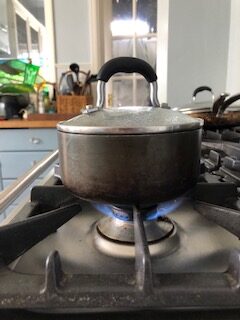
Image: Karen Costello-McFeat
Low energy cooking
Microwaves, slow-cookers, pressure cookers and air-fryers are all great ways to reduce energy costs, but I do not have space in the kitchen for such things. However, they are not vital if you follow a few basic steps.
- Put a lid on it! Food cooks much faster and at a lower heat this way.
- Let it cook itself. I cook almost everything using residual heat. By bringing to a full boil and then switching off, with the lid on, most vegetables, soups and beans will cook fully without any further heat at all. (You can always give it a quick blast at the end if needed.)
- Soak before you cook. By rinsing and soaking rice and beans before cooking, you can reduce the cooking times by about half. Great news for those of us who use brown rice.
- Match the pot with the hob. Putting a small pan on a big one simply heats the air.
- Fill the oven. If one of the items you are cooking requires an oven, fill the rest with vegetables rather than boiling them separately. If baking, make an assortment requiring the same temperature: bread and scones for example.
- Batch cook. There is some truly great stuff on YouTube here. Cooking in bulk is always more economical than in small portions and has the wonderful advantage of having a ‘ready meal’ available when you are tired.
Cool things
When it comes to economising on our grocery bills, our fridge and freezer are our greatest allies, allowing us to keep food fresh and safe for longer.
We can maximise this further by following a few simple rules: keeping our freezer full; defrosting items in the fridge and ensuring that meals are cool before putting in either.
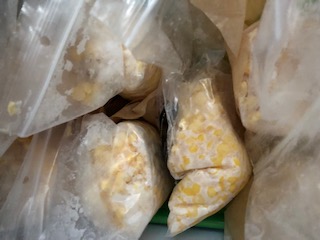
Image: Karen Costello-McFeat
The freezer is my most treasured appliance for allowing me to store excess fresh foods – like the cooking apples from the garden – and for enabling batch cooking.
Recently, I’ve started using more pulses – peas, beans and lentils – and unless you buy them tinned, they require some preparation. My solution? I buy as much as a kilo of dried organic ones from the health food store, soak the whole lot overnight, cook using the residual heat method, cool and store in portion sized amounts. There is minimal waste and I always have the base of a meal to hand. They don’t even need to defrost – just add them to the pot with liquid.
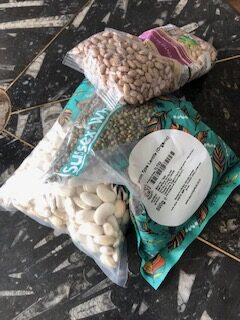
If you have a local green grocer, they will often have seasonal produce at very low prices. With a tiny bit of cooking, almost all fruits and vegetables can be frozen. With my garden bursting with fruit at the moment, I am certainly filling the freezer to enjoy the bounty when winter comes. And if you don’t have your own produce, let others know you’d be happy to pick some for a share. Most of us are happy to give it away.
Keep it simple
The less your food is processed, the less it will cost. This may seem obvious, but too often we choose the ‘easy’ option rather than cooking ourselves. I know. I’ve done it often enough.
It is worth remembering that every stage a meal goes through that requires the input of another, adds to the price. It also adds to the environmental cost in packaging and transportation, with the worst offenders being take-away food.
The irony is that most of these easy meals are just that. They require simple, basic ingredients and not a great deal of skill, yet supermarket shelves are filled with bottled pasta sauce and pre-packaged macaroni and cheese. They even sell frozen precooked rice (!?)
As someone with very limited energy, I totally understand the desire to come home and simply open a can or put something in the microwave, but it is often a false economy of both time and money.

Image: Photo by Krzysztof Hepner on Unsplash
Last night, as a little thought experiment, I wondered what it would cost to feed a family of four at McDonald’s. To buy the cheapest, smallest burger with fries and a Coke would set a family back £13.08 plus driving to the restaurant and waiting.
In contrast, using Asda’s essential brands, one could buy more than twice that: 8 burgers, 12 rolls, one lettuce, 6 tomatoes, a bag of French fries, and 1.5 litres of Coke for less than £10. And the time taken to prepare? Probably less than getting the kids in the car.
This is an extreme example, but the point is the same. Despite having a very complicated diet, I seldom spend as much as half and hour in the kitchen. By making twice what we need, usually, that time is effectively halved (excluding reheating). Food doesn’t get much faster than that.
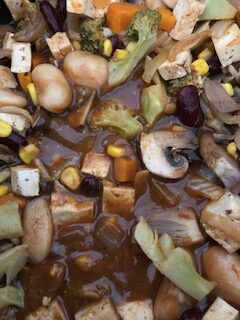
Image: Karen Costello-McFeat
Love those left-overs
With domestic food waste at about 30% in this country, we really need to learn to love our left-overs. Food production is one of the greatest users of energy, so when we waste it, we waste not only good food we could eat but the Earth’s resources too.
Many foods like soups and stews taste better the next day. We need only refrigerate them. A few items, like cooked rice, are best to freeze rather than chill. If in doubt, check food safety advice.
Shop adventurously
My final tip is perhaps a little quirky, but I hope it will inspire a few of you. We often fall into the habit of shopping at just one supermarket and forget the plethora of choices elsewhere.
More recently, I’ve been trying to spread my options. Flour, I have sent direct from the mill; fruit and vegetables from my local grocer; healthy staples from the on-line wholefoods company and anything exotic from the wonderful shops in the more multi-cultural part of town.
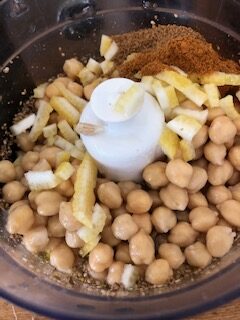
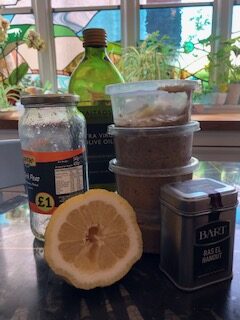
When it comes to canny cooks, those from foreign climes excel. Rice is bought in sacks and staples in bulk. They are masters of preserving in oil, vinegar and brine. Since they usually cook from scratch, there is always an amazing array of flours, herbs and spices on offer too. Generally, prices are very competitive. The large glass jar of chickpeas that my husband bought in Waitrose for almost £4 was £1 in our specialist shop. Such shopping trips are always inspirational.
A request
I could witter on for some time on this topic and there is much more to say, but for now, I’m going to turn it over to you. If you have any money saving tips on food preparation, energy or shopping, please put it in the comments section below. This is the kind of news from which we can all benefit.

Some great tips Karen. And you’re so right about processed – and ultra-processed – food. They’re false economy. Unfortunately, they tend to be the only items available to people on low incomes or without access to cooking facilities.
You’ve covered most of my top tips, but I would add planning ahead in there too. It doesn’t have to be some rigid programme you have to follow no matter what, but it cuts down on food waste as you know what you need when shopping and therefore don’t over shop. Oh, and avoiding offers unless it’s something you actually want to buy!
I’ll definitely second your tips! Planning is always a good idea. xx
All great tips that I have used myself! Living on my own, I definitely recommend batch cooking to maximise efficiency in all ways! I cook everything from scratch and have had one takeaway in 14 months… and was so disappointed with it that I threw it away! I use that as a memory whenever I’m tempted. Yes it is also very expensive, so it’s a no-brainer to cook healthy meals at home and freeze in batches – especially meals that take a while to put together, for example Lasagne freezes really well cut into portions.
When you soak rice, only do this for about 20 minutes before draining in a sieve and drying out a bit before cooking by the absorption method. Any more and it will break and cause a more gluey rice. Soaked properly it will cook quicker as you say, and you will end up with lovely fluffy and separated grains when cooked. Indians always use this method.
Keep chilled rice for a stir fry the next day. Never use just-cooked or heaven-forbid hot rice for a stir fry as I’m sure you all know.
I’ve recently discovered these tiny little silicon covers (also in larger sizes – Kmart) to avoid the use of cling film for things like half lemons and tomatoes. Waxed wraps are also amazing of course.
It seems I have the ability to ‘witter’ on too hahaha
I am so privileged to have some very expert cooks replying to my blog (thank you Karen and Lys)! I didn’t realise that I shouldn’t soak rice too long and I take your advice on all things Indian. I should introduce you two – Karen Lee also lived in India for a while!
I didn’t have a clue on stir fry, I confess.
Covers and wax wraps are the best for keeping large and small left-overs happy.
Thank you for your helpful comments! xxx
Thanks for the step by step instructions. Really helpful guide.
So glad it was useful x